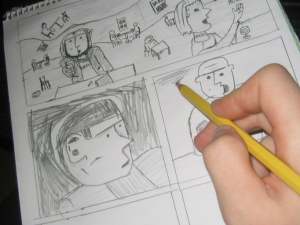Top Qs
Timeline
Chat
Perspective
Sequential art
Sequence of images used for storytelling From Wikipedia, the free encyclopedia
Remove ads
In comics studies, sequential art is a term proposed by comics artist Will Eisner[1] to describe art forms that use images deployed in a specific order for the purpose of graphic storytelling[2] (i.e., narration of graphic stories)[3] or conveying information.[2] The best-known example of sequential art is comics.[4]

Remove ads
Etymology
The term "sequential art" was coined in 1985 by comics artist Will Eisner in his book Comics and Sequential Art.[1] Eisner analyzed this form into four elements: design, drawing, caricature, and writing.[1]
Scott McCloud, another comics artist, elaborated the explanation further, in his books Understanding Comics (1993) and Reinventing Comics (2000). In Understanding Comics, he notes that the movie roll, before it is being projected, arguably could be seen as a very slow comic.[5]

Related terms include: visual narrative,[6] graphic narrative,[7] pictorial narrative,[8] picto-narrative,[9] sequential narrative,[10] sequential pictorial narrative,[11] sequential storytelling,[12][13] graphic fiction,[14] graphic literature,[15][12][16][17] pictorial literature,[18] sequential literature,[19] and narrative illustration.[20] The related term sequential sculpture has also been used.[21]
Remove ads
See also
References
Wikiwand - on
Seamless Wikipedia browsing. On steroids.
Remove ads
